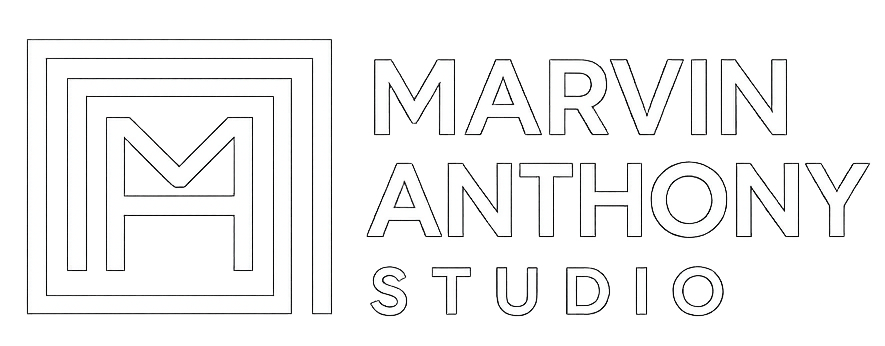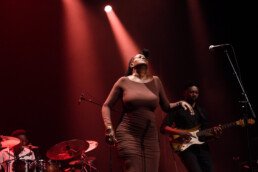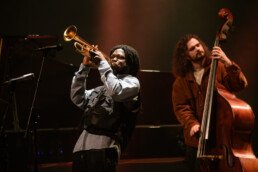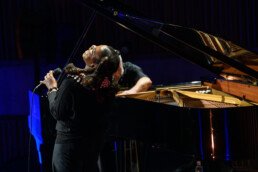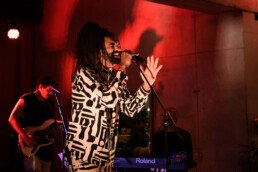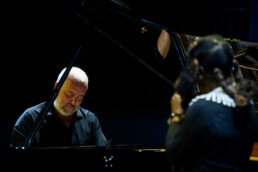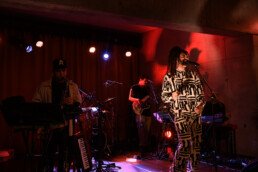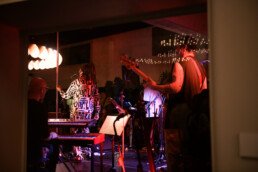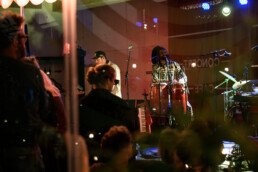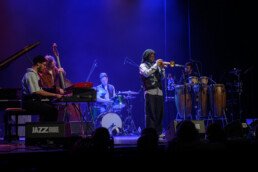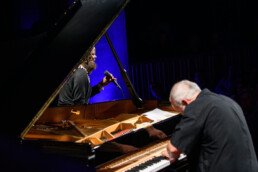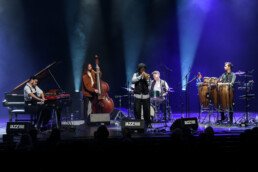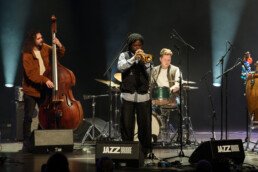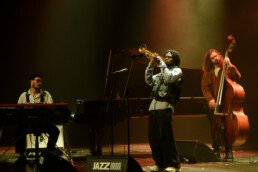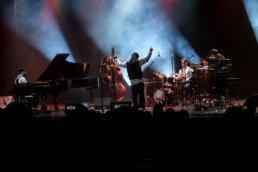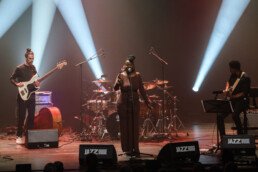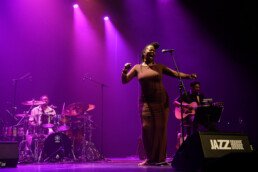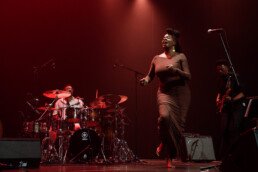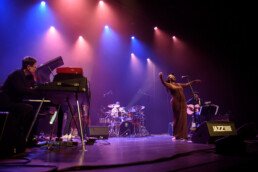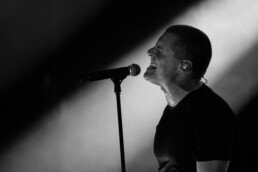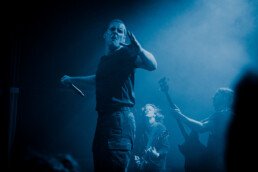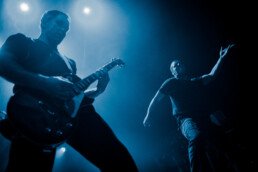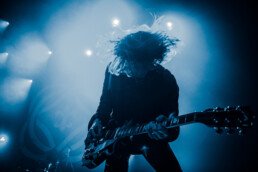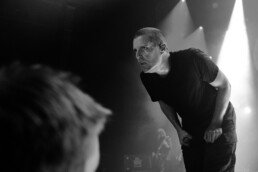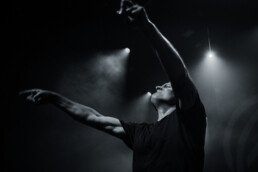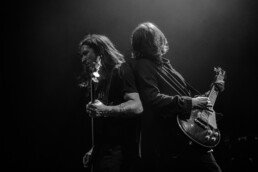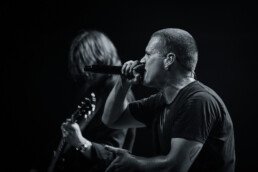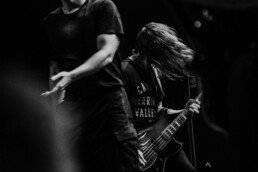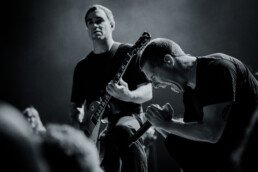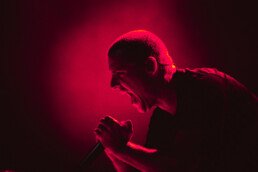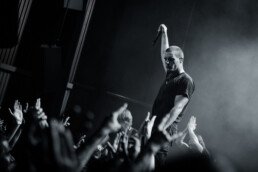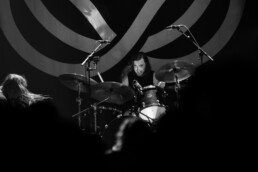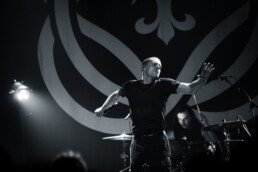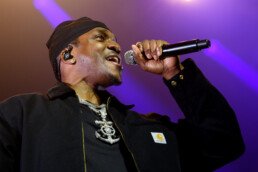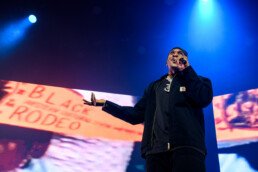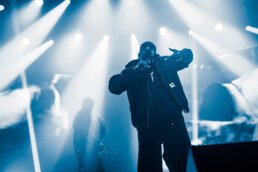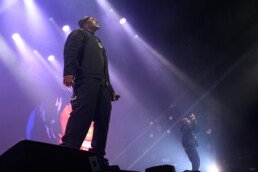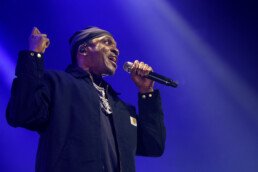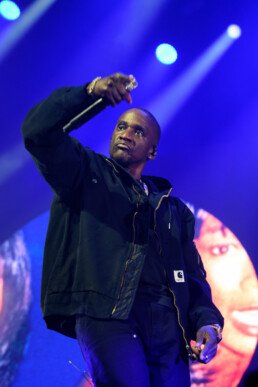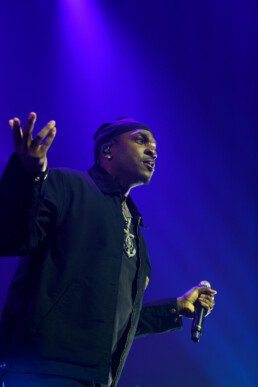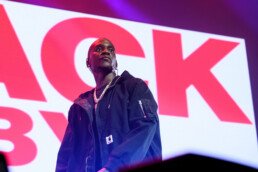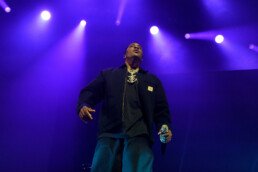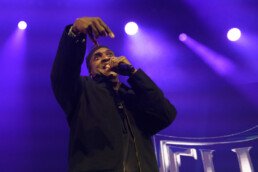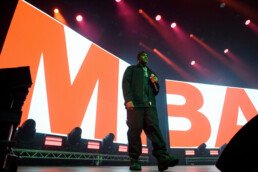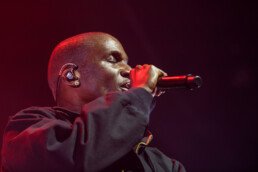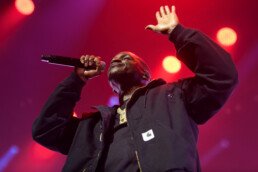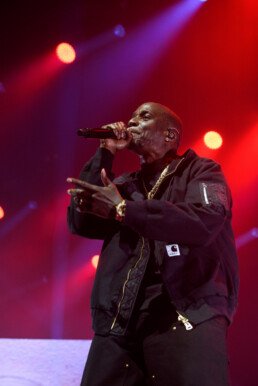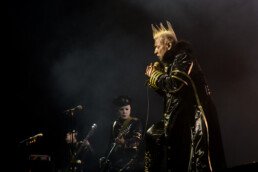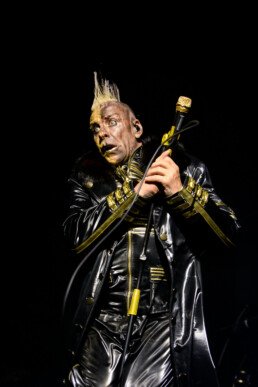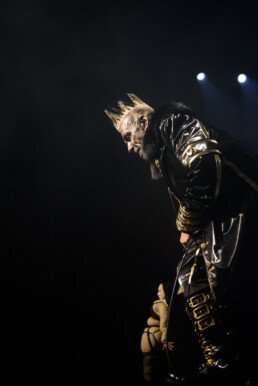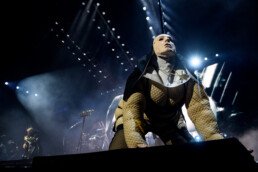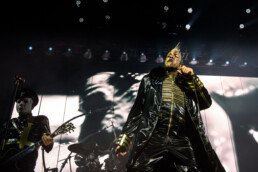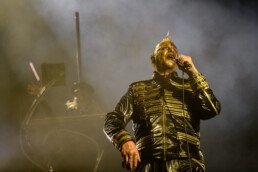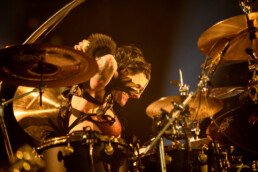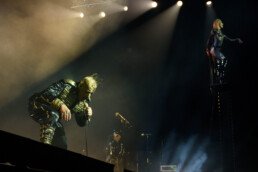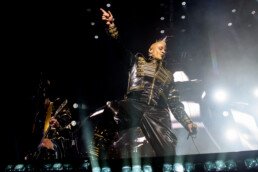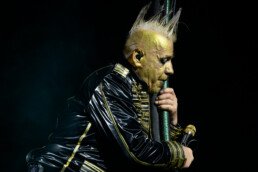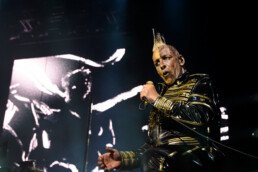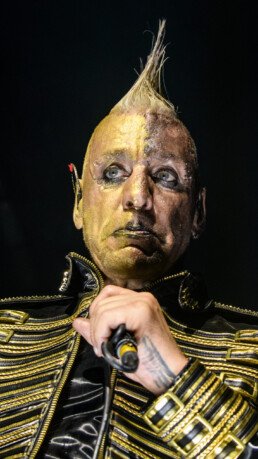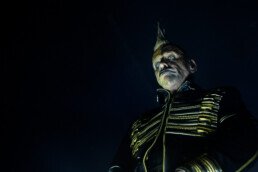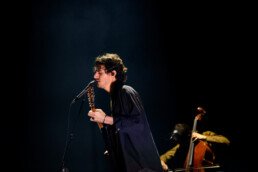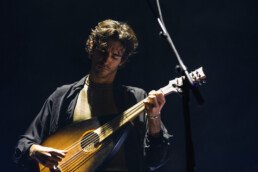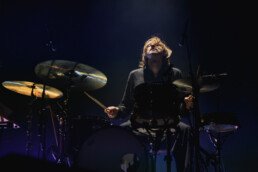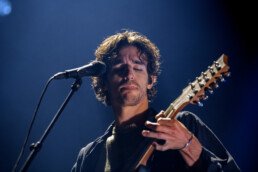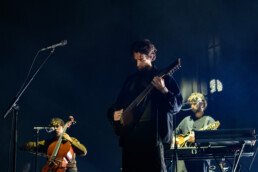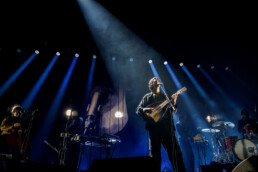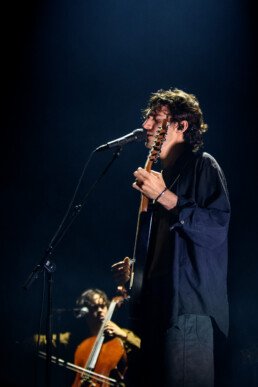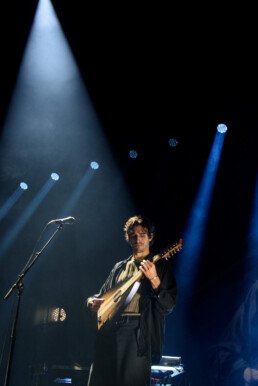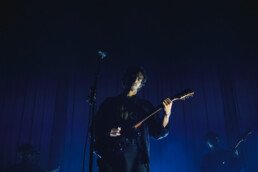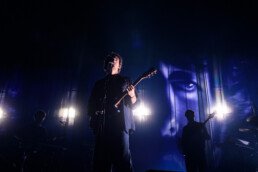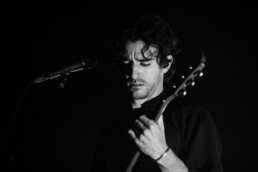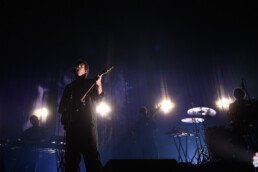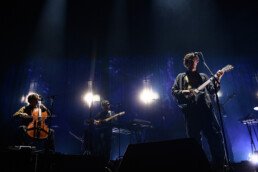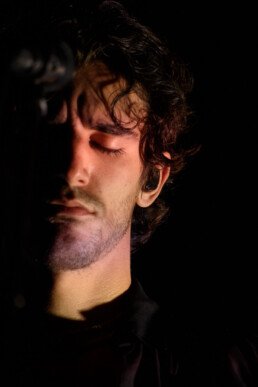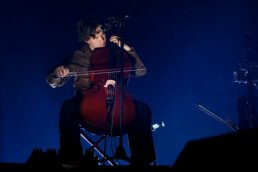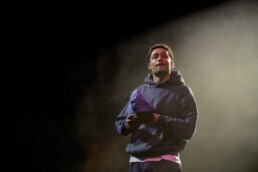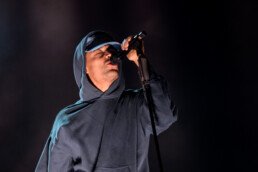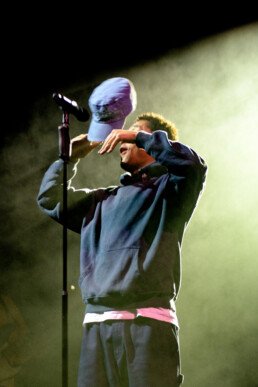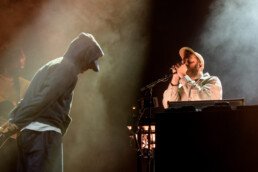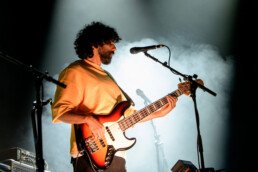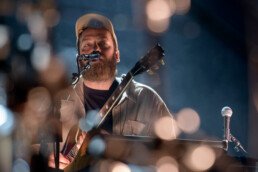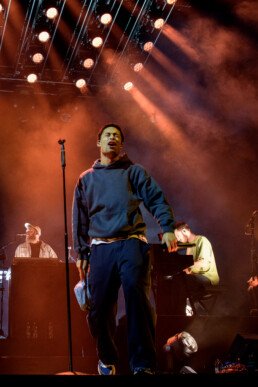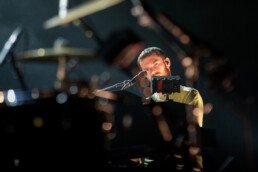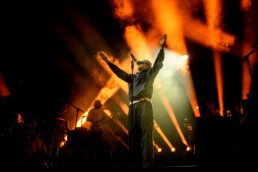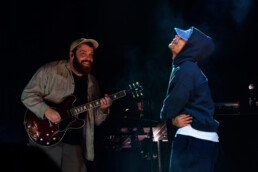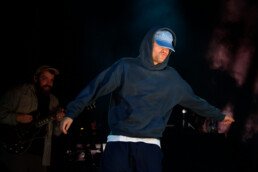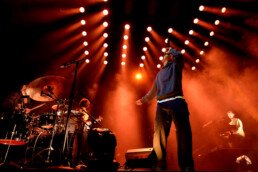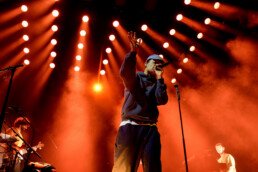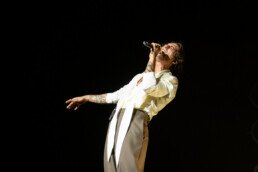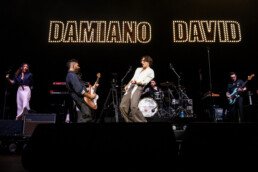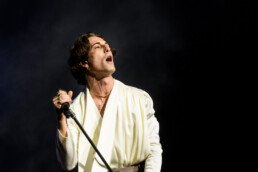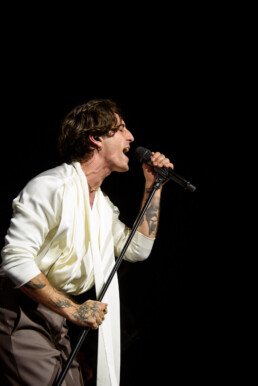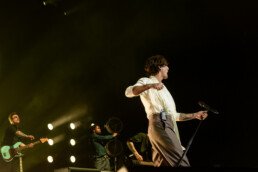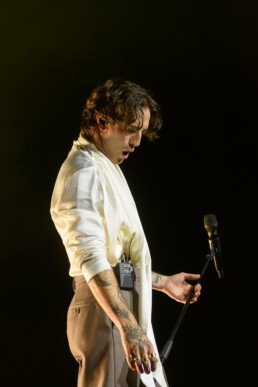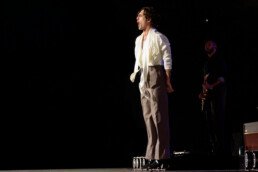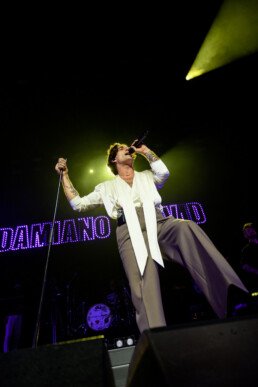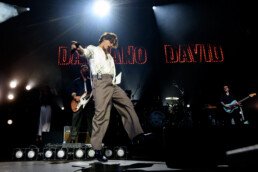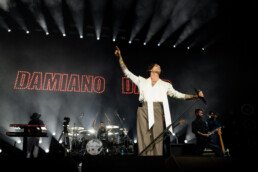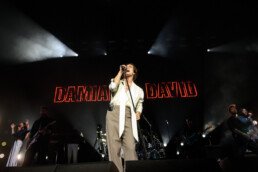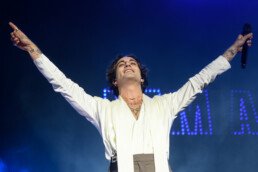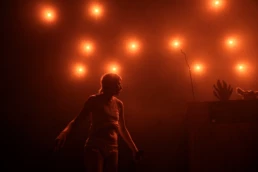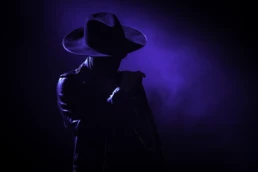Jazz Brugge 2025 | Concert Photography by Marvin Anthony
Marvin Anthony
14 November 2025 · Concertgebouw Brugge · © Marvin Anthony Studio
Crossing cultures through rhythm, voice and light.
Jazz Brugge opened its doors with a warmth that felt both rooted and restless. Somi brought the Great Hall to life with a voice that rose like sunlight through stained glass, bright and precise, carrying Harlem, Rwanda and Uganda in every note. Her band moved with the same ease, each solo a thread in a tapestry that felt celebratory even when the themes reached deeper into memory and migration. Later op the evening the Peter Somuah Group filled the space with brass and pulse, a sound built from Ghanaian highlife and the wide breath of jazz, a rhythm that travelled straight from West Africa to the soft chairs of Bruges. What the festival promised became true in the room. Cultures met, mixed and lifted each other without effort. These images hold the glow of that first night, a crossing of voices, hearts and histories.
Featured In Press
“Jazz Brugge opende met Somi en de Peter Somuah Group, een avond waarin jazz, Afrikaanse ritmes en levenslust elkaar vonden. Van Harlem tot Ghana klonk overal dezelfde warme hartslag.”
— Peter De Backer, De Standaard (15 Nov 2025)
Review: “Jazz Brugge: muzikale kruisbestuiving met Afrikaanse danspasjes”
Read the full review →
“Voor de eerste festivaldag van Jazz Brugge werd resoluut de kaart van de diversiteit getrokken. Van het dynamische duo Désir en Fiorini tot de warme grooves van Somi en de swingende highlife van de Peter Somuah Group, elk concert kleurde de avond op een eigen manier.”
— Pablo Smet, Jazz&mo’ (14 Nov 2025)
Review: “Divers dansen op dag 1”
Read the full review →
Photography © Marvin Anthony.
Deafheaven at Cactus Muziekclub Bruges | Concert Photography 2025
Marvin Anthony
10 November 2025 · Cactus Muziekclub Brugge · © Marvin Anthony Studio
Deafheaven Cactus Muziekclub Brugge – Gallery.
Deafheaven turned the small Cactus Muziekclub into a storm of sound and light. Every note moved like weather across the room, fierce yet strangely tender. The guitars shimmered, the drums struck like distant thunder, and George Clarke carried the space with the wild precision of someone caught between fury and prayer. The crowd felt the pull of something larger than volume alone, a wave that lifted and cleansed at once. These images hold what words cannot, the silence that follows after the noise and the beauty that survives inside it.
“Deafheaven liet Brugge daveren met een geluidsmuur van jewelste, waar brutaliteit en schoonheid elkaar raakten. George Clarke gilde, gruntte en beval de menigte tot overgave, gedragen door een band die storm en stilte in balans hield.”
— Jan-Willem Declercq, Dansende Beren (11 Nov 2025)
Featured In Press
Review: “Deafheaven @ Cactus Muziekcentrum (Club): Brutaliteit op zijn schoonst”
Read the full review →
Photography © Marvin Anthony.
Setlist — Deadheaven @ Cactus Muziekclub (Brugge, 10 Nov 2025)
- Incidental
- Doberman
- Magnolia
- Brought to the Water
- Sunbather
- The Garden Route
- Body Behavior
- Amethyst
- Incidental II
- Revelator
- Dream House
- Winona
Clipse at 013 Tilburg | Legacy Reloaded
Marvin Anthony
5 November 2025 · 013 Poppodium Tilburg · © Marvin Anthony Studio
Clipse 013 Poppodium Tilburg – Let God Sort ’Em Out Tour Review.
When the lights dimmed inside 013 Poppodium, the energy in the room shifted like it knew what was coming. Two towering screens flickered to life: “There comes a time when we must answer to the truth,” before the warning from their new record looped through the PA: “This is culturally inappropriate.” Then came the crack of “Chains & Whips.” Fifteen years after their split, Clipse walked out of the shadows like time had learned to wait for them.
Pusha T took the first verse, his delivery cool and clipped, every syllable landing clean. Malice followed moments later, and the crowd’s chants rolled through the hall. There was no need for introductions. Just two brothers, two microphones, and a chemistry that still burns through any generation gap.
Earlier, Jev had set the tone: a sharp and confident warm-up that turned 013 into one giant grin. His mix of rhythm, bounce, and precision loosened the crowd perfectly. By the time Clipse arrived, the room was ready to take it up a notch.
From there, the setlist ran like a timeline. The new album Let God Sort ‘Em Out dominated the first half: “P.O.V.”, “Popular Demand (Popeyes)”, and “What Happened to That Boy” (Birdman cover) appeared early before the brothers dug into deeper cuts like “M.T.B.T.T.F.”, “Inglorious Bastards”, “Momma I’m So Sorry”, “Keys Open Doors”, and “Mr. Me Too.” When “Grindin'” hit, you could feel the floor move. Fans didn’t just rap along; they slapped the rhythm on their chests, lunch-table style, like muscle memory.
The production framed it all: quick-cut footage of courtroom scenes, soldiers, luxury ads, and home videos looping behind them. Equal parts menace and nostalgia. “F.I.C.O.” and “So Be It” carried the weight of their new material, tight and deliberate, before “Ace Trumpets” turned the venue gold with its brass-heavy pulse. They downshifted into “The Birds Don’t Sing,” a quiet, emotional center point that drew the room still.
That last song froze the hall. Family photos filled both screens, the crowd fell silent, and the Thornton brothers rapped their way through loss, memory, and gratitude. No theatrics, just truth. They closed with “So Far Ahead,” fading into darkness while their logo lit the walls.
The last time Dutch fans saw Clipse live was February 2010 at Bitterzoet in Amsterdam, a sweat-slicked 350-capacity club where Kempi opened the night. Bitterzoet’s intimacy, elbows on stage and condensation on the ceiling, is a world away from 013’s 3,000-capacity main hall, a precision-engineered beast built for scale. But Clipse managed to shrink the distance. Even in the big room, it felt eye-level.
No guests tonight, just command. Every word enunciated, no lip-sync safety net, pure craft. Malice beamed through verses that felt both peaceful and razor-sharp. Pusha controlled the pacing like a conductor, turning nostalgia into motion.
There is a lot of talk about legacy in hip-hop. Clipse do not talk, they embody it. Fifteen years later, the brothers from Virginia Beach perform like they never left in 60 minutes.
With their European run now in full swing, Clipse continue the Let God Sort ‘Em Out Tour with shows in Paris, London, and Manchester before heading back to the United States for festival dates in Los Angeles, Virginia Beach, and Brooklyn. The tour then resumes in 2026 with major appearances at Coachella and All Points East in London. Fans looking for Clipse tour dates, tickets, or setlists across Europe, the UK, or the U.S. can find them on the group’s official site. The brothers have hinted that 2026 may bring another leg.
Setlist — Clipse @ 013 Poppodium (Tilburg, 5 Nov 2025)
- Chains & Whips
- P.O.V.
- Popular Demand (Popeyes)
- What Happened to That Boy (Birdman cover)
- M.T.B.T.T.F.
- Inglorious Bastards
- Momma I’m So Sorry
- Keys Open Doors
- Mr. Me Too
- Grindin’
- F.I.C.O.
- So Be It
- Ace Trumpets
- The Birds Don’t Sing
- So Far Ahead
Till Lindemann at AFAS Dome Antwerp | Meine Welt Tour Photography
Marvin Anthony
2 November 2025 · AFAS Dome Antwerp · © Marvin Anthony Studio
Provocation as theatre, precision as ritual.
The Meine Welt Tour turned Antwerp into theatre, smoke, gold light, and a pulse that felt equal parts ritual and riot.
Till Lindemann directing the AFAS Dome with calculated provocation and machine-tight precision, each flash of light syncing perfectly with his voice. Here’s the night, frozen in some images
“Zo keerde Lindemann terug naar Antwerpen met een vrij emotieloze, doch theatrale show – wederom choquerend, maar op zorgvuldiger gekozen momenten dan in de Lotto Arena.”
— Stijn De Belder, Dansende Beren (3 Nov 2025)
Featured In Press
Review: “Till Lindemann @ AFAS Dome: Pastoor van de provocatie”
Read the full review →
Photography © Marvin Anthony.
Setlist — Till Lindemann @ AFAS Dome (Antwerp, 3 Nov 2025)
- Meine Welt (Intro)
- Fat (Lindemann song)
- Und die Engel singen
- Schweiss
- Altes Fleisch
- Golden Shower (Lindemann song)
- Sport frei
- Tanzlehrerin
- Blut (Lindemann song)
- Allesfresser (Lindemann song)
- Prostitution
- Praise Abort (Lindemann song)
- Platz Eins (Lindemann song)
- Du hast kein Herz
- Skills in Pills (Lindemann song)
Encore:
- Übers Meer / Knebel (live debut)
- Fish On (tour debut)
- Ich hasse Kinder
Song played from tape: Home Sweet Home (Lindemann song)
Tamino at Vorst Nationaal – A Night of Quiet Majesty
Marvin Anthony
31 october 2025 · Vorst Nationaal · © Marvin Anthony Studio
He walked on stage, and silence followed. Light fell like prayer; strings trembled like breath. For a moment, even the concrete of Forest National in Brussels sounded holy.
This gallery documents the closing night of Tamino’s Every Dawn’s a Mountain tour in Brussels. A performance where stillness was its own form of volume.
“En precies daar schuilt Tamino’s magie.
Zijn muziek vraagt geen collectieve ontlading, maar nodigt uit tot verstilling.”
— Stanne Meulemans, Dansende Beren (1 Nov 2025)
Featured In Press
Images from this gallery were published in the review
“Tamino @ Vorst Nationaal: Luider worden stiltes niet”
Photography © CPU – Marvin Anthony.
Read the full review →
Setlist — Tamino @ Vorst Nationaal, Every Dawn’s a Mountain Tour (Brussels, 31 October 2025)
- My Heroine
- Raven
- The First Disciple
- Willow
- Sanctuary
- The Flame
- A Drop of Blood
- Every Dawn’s a Mountain
- Elegy
- Sleep Talking (new song)
- Tummy
- Persephone
- w.o.t.h.
- Indigo Night
- Babylon (sang happy birthday to his brother, Ramy, before playing)Encore:
- Habibi
- Dissolve
- Smile
Loyle Carner at Vorst Nationaal | There Is Always Hope
Marvin Anthony
25 Oct 2025 · Vorst Nationaal Brussels · © Marvin Anthony Studio
Vulnerability as rhythm, hope as pulse.
Loyle Carner turned Vorst Nationaal into a space of warmth, honesty, and reflection. Surrounded by a live band and a crowd that breathed with every verse, he proved again that rap can sound like hope itself.
These images capture that quiet power. The glow between humility and joy.
“Er bestaan artiesten die ons doen vóélen. Loyle Carner is daarvan een zeldzaam voorbeeld bij uitstek.”
— Liese Vanherwegen, Dansende Beren (26 Oct 2025)
Featured In Press
Review: “Loyle Carner @ Vorst Nationaal: Er is altijd hoop”
Read the full review →
Photography © Marvin Anthony.
Setlist — Loyle Carner @ Vorst Nationaal (Brussels, 25 Oct 2025)
- In My Mind
- All I Need
- Ain’t Nothing Changed
- Yesterday
- Damselfly
- Horcrux
- Desoleil (Brilliant Corners)
- Homerton
- Nobody Knows (Ladas Road)
- Purpose (feat. Navy Blue)
- Lyin
- Still
- Loose Ends
- Ice Water
- Speed of Plight
- About Time
- Ottolenghi
- A Lasting Place
Damiano David at Vorst Nationaal | World Tour 2025
Marvin Anthony
2 October 2025 · Vorst Nationaal Brussels · © Marvin Anthony Studio
Between rock scars and pop glow, a performer learning to breathe again.
Under the golden haze of Vorst Nationaal, Damiano David re-entered the stage as someone else. Not the swaggering rock frontman of Måneskin, but a solitary figure testing his own softness.
The screams stayed; the distortion faded. Between synths, sweat and restraint, a new language began to form. Fragile, but still ablaze.
“Wie nog steeds de rock van Måneskin zocht, zat gisteren in Vorst Nationaal op de verkeerde plaats. Damiano David zit al een hoofdstuk verder en wij beginnen stilletjesaan te volgen.”
— Robbie Allemeesch, Dansende Beren (3 Oct 2025)
Featured In Press
Review: “Damiano David @ Vorst Nationaal: De zachte kant opzoeken”
Read the full review →
Photography © Marvin Anthony.
Setlist — Damiano David @ Vorst Nationaal (Brussels, 2 October 2025)
- Born With a Broken Heart
- The First Time
- Mysterious Girl
- Voices
- Cinnamon
- Locked Out of Heaven (Bruno Mars cover)
- Talk to Me
- Nothing Breaks Like a Heart (Miley Cyrus cover)
- Perfect Life
- Next Summer
- Sick of Myself
- The Bruise
- Tangerine
- Zombie Lady
- Tango
- Angel
- Over
- Mars
Encore:
- The First Time (Reprise)
- Naked / Solitude (No One Understands Me)
Why Most Music Photos Look the Same and What I Try To Do Differently
Okay, okay, let’s get real here for a minute. You know what I mean? You’re browsing your phone, maybe after some festival, or just checking out what’s out there and honest to God, every music photo starts to look… the same? Like, you’ve seen the same photo a million times. It’s not you. Even when the photos are, like, technically fine, they all just end up this one big, dull stew of “meh.”
And here’s the kicker if you’re the one taking those photos, or you’re a band paying for them, that’s a problem. A big one. Because if your pictures look like everyone else’s, how the hell is anyone supposed to notice you? You’re just… more noise.
Seriously, Why Does Everything Look the Damn Same?
Get in any photo pit. Go ahead. You’ll see. The same super wide angles from the same darn spot. The same awkward portrait poses. And oh god, the edit trends! Everyone jumps on the same Instagram filter like it’s some kind of holy grail for three months, then on to the next one.
And why? Why are we doing this? Part of it, yeah, is the industry pressure. It’s incessant. Everything’s gotta be FAST. Photographers are squeezed for crazy quick turnarounds, you’ve got that stupid “three songs, no flash” rule handcuffing people, and then clients bless ’em often just want something “safe” because safe is, well, predictable. But then, you’ve also got this thing where photo trends spread like wildfire, just like in music. So everyone ends up chasing the same look. It’s a cycle.
And what are you receiving in return? Photos that, sure, prove you were on stage. Great. But are they stopping traffic as folks scroll past? Are they stirring any sort of feeling? Are they communicating anything about what makes your band unique out of the ten thousand other bands trying to get folks’ attention? Probably not.
So, What Am I Trying To Do About It?
Look, I approached it with a fairly straightforward concept: your music images ought to be as bold and individual as your music. They need to strike people, not merely check a box.
So no, I’m not just going to walk in and shove a lens in your face. First, first things? I’ve got to get your music. I mean, get it. What are you? What’s the vibe? What’s the story that you’re telling? Because if I get that, then I can start thinking about pictures that are about who you are, not what you look like with a guitar in your hand.
And I don’t have to be worrying about what’s in this week. My style? That’s derived from making actual choices in terms of how I compose a shot, how I interact with light (or, you know, not interact with it!), how I postprocess it afterwards, all in the service of communicating what we want to communicate. The mission isn’t creating pictures that scream “that’s one of my pictures!” It’s creating pictures that scream, “that’s them! That’s the band!”
And this is the doozy for me: I’m always looking for those in-between moments. The off-guard moments. The real connections. Those sparks that flash when nobody’s “on.” That’s where the gold is, man. A heck of a lot more than in some technically proficient shot that’s absent of heart.
Why Should You Even Care About This Stuff?
Listen, your followers, all of them, they are bombarded with images online. Hundreds a day. If your images are going to have some thought, some heart in them, if they reveal some truth about you? They will get through. People will not scroll. They’ll remember.
And on top of that, when your visuals match your music, with your story, it just resonates with people on another level. People aren’t stupid; they can smell out BS from a mile away. When the visuals are genuine, it just provides that bond with your fans that little bit more.
This isn’t about pretty photos for your Instagram feed. This is about getting rid of a visual identity that’s 100% you. In a world where everybody’s doing so much to sound different, why on planet earth would you want to look the same?
The Real Deal Is Collaborating
When I’m working with bands, with artists, with their whole team, even, what I’m enthusiastic about is making it an actual collaboration. I want to understand what you need your pictures to say. What do you need to do? What is the message? Because the good stuff, the great stuff, happens when it’s not merely me taking your picture; it’s when we’re creating something together.
Every musician I work with gets something unique. Your music doesn’t come off the assembly line, so why should your photographs? If you’re more of a folk singer-songwriter type with an acoustic guitar or all-out metal band trying to blow the roof at the end of the day, the intention is always the same: take pictures that, in some way, just feel, totally, completely you.
Behind the Pit: How I Get You a Full Gallery in 3 Hours
So this is what it’s like in the music industry everything moves fast. Like, stupid fast. One minute you’re rocking the stage, the next minute you’re requesting photos ASAP because otherwise people are gonna forget you even played a show. I’ve been around this long enough to know that when a band or manager says they want pictures “as soon as possible,” they mean business.
That’s why I’ve spent years studying how to deliver a finished, fully edited gallery in three hours from the last song. Not because I’m rushing through shots and cutting corners. Hell no. It’s because I’ve built my entire workflow for speed without sacrificing quality.
Why Everyone's Always in a Rush
The internet doesn’t sleep, and neither does the music industry.
Social Media Won’t Wait: Your followers are already looking at Instagram in the parking lot after your show. They have to re-live it while they’re still pumped up from doing so. Miss the moment, and you’re competing with whatever else is happening in their stream.
Press Deadlines Are Real: I’ve dealt with enough music writers to know that they’re usually writing the review with a 1 AM deadline. If you want your pictures in that story, you’d better get them over in a hurry.
Artists Are Human: Bands put everything into a show, and they care how it looks. They want to pass it along, to commemorate it, to utilise it. Stretching, waiting for photos out by three days completely kills that energy.
How I Pull This Off
It isn’t magic, but just a “healthy obsession” with processes. Everything in my workflow is designed to eliminate bottlenecks and downtime.
Before I Even Pick Up a Camera
The Pre-Show Chat: I do talk to bands before shows. Extreme concept, isn’t it? Seriously, though, I need to know what’s most important. Is this for social media? Do you need certain shots for press purposes? Are there sponsors that must be included? This isn’t small talk it affects the way I shoot and what I pay attention to when I’m editing.
Shot Lists That Work: What we talked about, I take headnotes of shots that absolutely must appear. Not a tight script, but priorities. If you mentioned that you needed to have good crowd shots, I’m getting them ready. If there is a guitar solo that always occurs, I’ve got it ready.
Gear That’s Ready to Go: My gear is organised in the style of an F1 pit crew. Several camera bodies, lenses for every possible lighting condition, batteries that are charged when I need them, memory cards that can handle the occasional rapid burst. All tested and ready before I enter the venue.
During the Show
Shooting Smart, Not Hard: After doing this for so many years, I can read a room. I can sense when the energy’s building, where the good spots are, how to compensate for dreadful venue lighting. I’m not shooting blindly hoping something will work.
Moving On the Fly: In between sets or when we are in slow times, I’m already transferring photographs from cards onto my computer. It isn’t always possible, but when it is, it is a tremendous time saver.
Rating as I Go: If there’s ever any slack time at all during the show, I’m rating those shots quickly as they come in. Five stars for the keepers, one star for the easiest rejections. This saves sorting time later by probably 70%.
The Edit Bay Sprint
Culling Like a Rockstar: I do initial sorts with Photo Mechanic because it’s sodding fast with RAW files. No AI yet, just experience knowing what does and what doesn’t work. I can sort 500 photos in under 10 minutes.
Batch Everything (Except I Don’t): While many photographers rely heavily on batch editing, I rarely do. I aim to get it 90% right in-camera, so most of my final adjustments happen individually in Lightroom. Every shot gets its own attention where it matters because a killer live photo deserves more than a cookie-cutter preset.
Preset Power: I have editing presets for all standard concert lighting scenarios. Red stage wash? There’s a preset for that. Harsh white spotlights? Got it covered with a preset. These aren’t one-size-fits-all solutions, but they’re great starting points that save massive amounts of time.
Metadata on Autopilot: At the time of export, I’m applying captioning, keywords, and copyright information based on templates I’ve created. This matters for searchability and protection, but it has to be done in ways that are not time-consuming.
The Technology That Makes It Happen
Equipment That Doesn’t Give Up: high-speed memory cards, pro card readers, a computer that can really process RAW files without complaining. This gear isn’t cheap, but it’s what it takes to deliver this kind of turnaround.
Software That Gets Along: my editing station is optimized for speed. Lightroom for the bulk of my corrections, Photo Mechanic for sorting through, and delivery companies that can handle uploading huge files without timing out.
Upload While You Sleep: Last galleries go online on pro sites where clients download immediately. No waiting for attachment via email or file size limitations.
What This Actually Gets You
Having images back in hours instead of days isn’t just convenient. It opens up possibilities of how you can work.
Strike While It’s Hot: Post those photos while people are still grinning because of your show. Tag the venue, opening bands, the people who were there. That immediate connection is worth so much more than polished photos posted next week.
Real-Life Press Coverage: Music blogs are quick. Feed them great photos the night of the performance, and you’re much more likely to be showcased. Wait three days, and they’ve jumped to the next show.
Keep the Momentum Going: A performance that’s worth its while isn’t done when you exit stage. Having pro-quality photos instantly available keeps that momentum going into your social media, your press kit, your next gig booking pitch.
It’s All About Being Prepared and Not Rushing
This is my framework. This pace is not attained by scrambling and hastening the photography itself. When I am in that zone, I am producing, sensing the moment, getting the energy. The pace is realised through all else being so dialled-in that creative work can occur without technical resistance.
This only works, though, when we’re on the same page initially. If I understand what you’re going to need and when you’ll need it, I can structure everything around that. Communication before the show is what keeps things from being “pretty fast” and makes people think “holy shit, how did he do that?”
The Bottom Line
Timing is everything in music. Having your pictures at hand when folks are still buzzing about your performance isn’t nice to have; it’s a competitive edge. It lets you be in the conversation rather than struggling to catch up to it.
After years of refining this process, I can promise that you’ll have your whole gallery in three hours from the end of your set. Not because I’m cutting corners, but because I’ve stripped away all the junk that doesn’t need to be there. Your photos. Your timeline. Your flow. All protected.
